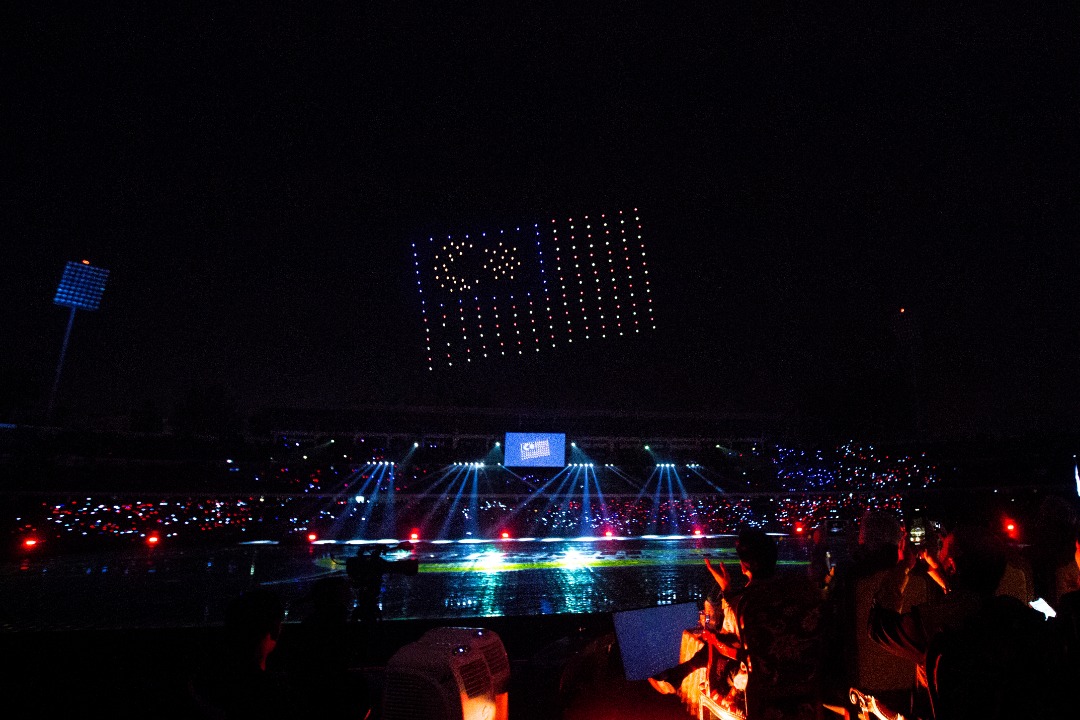For the first time ever, Intel brought its fleet of state-of-the-art drones to light up the skies in Malaysia. A total of 250 Intel Shooting Star Drones put up a dazzling display during the 19th Perak Malaysia Games (SUKMA) opening ceremony last week. The drones formed the SUKMA logo, the national and state flags, as well as the Bos Gaurus logo (Perak Football Club).
The Intel Shooting Star Drone is the company’s first drone created specifically for entertainment light shows. The ultra-lightweight drones are easily programmed, assembled and operated to create beautifully choreographed images in the night time sky.
Each drone only weighs 330g, constructed with a soft frame made of flexible plastics and foam. The quadcopter’s propellers are protected by cages, designed to ensure the drone is safe to fly and is splash proof. Each drone has enough juice for 5-8 minutes of flight time.
Unlike regular consumer and commercial drones, the Intel Shooting Star Drone does not have a camera but does have onboard GPS.
 The drones come with software and an animation interface that lets a single pilot on a single computer control the massive swarm of drones. A light show can be created in a matter of days, instead of weeks or months manually.
The drones come with software and an animation interface that lets a single pilot on a single computer control the massive swarm of drones. A light show can be created in a matter of days, instead of weeks or months manually.
Intel’s proprietary algorithms automate the animation creation process by an image. The system quickly calculates the number of drones needed, determines the position of the drones and formulates the fastest path to create the image in the sky.
 The software also runs a complete fleet pre-flight check and is able to select the most optimised drones for each flight based on battery life, GPS reception, and more.
The software also runs a complete fleet pre-flight check and is able to select the most optimised drones for each flight based on battery life, GPS reception, and more.
The fleet size is dependent on the animation needed and can range from hundreds or even more. Will we see 1,000 drones in the future? Never say never. Oh wait, it’s already been done.
In celebration of its 50th anniversary this year, Intel choreographed its biggest drone light show yet – with 2,018 Intel Shooting Star Drones.
Fusion of art and technology
Intel’s foray into drones began in 2015 when the company’s research team led by Natalie Cheung, successfully flew 100 Hummingbird drones made by Ascending Technology. The feat achieved in Germany helped Intel snag a Guinness World Record for the most drones airborne simultaneously.
The company went on to acquire Ascending Technologies and the Shooting Star drone was born.
Cheung took lead over the drone team and pulled off four international shows using 100 drones in 2016. I had the honour of meeting Cheung and getting up close and personal with the Shooting Star drone during Vivid Sydney – the largest light, music and ideas festival held annually in Sydney, Australia. It’s a spectacular festival that’s a culmination of creative arts and the best of technology.
Drone 100, Intel’s world-record-holding drone performance made a public debut at Vivid Sydney that year. One hundred illuminated drones performed a choreographed routine over Sydney Harbour, accompanied by the Sydney Youth Orchestra. Let me tell you this, it was breath-taking.
Intel went on to do even bigger, better drone shows with more drones including at the Coachella music festival, Singapore National day Parade and Super Bowl. Let’s not forget the epic 250-drone drone show over the Bellagio Hotel in Las Vegas to celebrate CES 2018.
https://www.youtube.com/watch?v=hAMPoLV9ODM
And the company continues to push boundaries of what’s possible. At the Olympic Winter Games PyeongChang 2018, Intel put 1,218 Intel Shooting Star drones in the sky, and set a new (again) Guinness World Record for the most UAVs airborne simultaneously.
https://youtu.be/fCd6P7Ya160
https://youtu.be/wFi5SkhUjR8
Read more about Intel drones.









